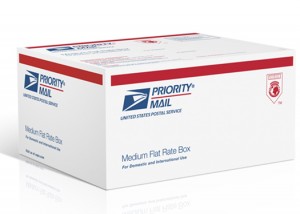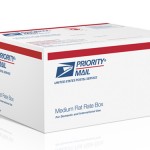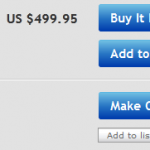 A little bit to my surprise, I recently earned “Top Rated Seller” (TRS) status on eBay. I knew I was a good seller, but I didn’t think that I sold enough to qualify. I usually see the TRS badge next to usernames with thousands of feedback ratings, and I had slightly more than 600 (and the majority of those as a buyer!). But, as it turned out, I had met the minimum threshold, which at the time was $3,000 in sales over the past year with at least 100 transactions plus strong feedback and “detailed seller ratings” (the five-star ratings). (TRS status will be easier to achieve on June 1, 2012, with the sales threshold lowered to only $1,000.) I kind of backed into TRS status. I don’t know how long I will be able to maintain the requirements to be a TRS, but as long as I do, I will share what I know about that fancy ribbon adorning all of my listings. I’ll begin with an overview of the program and follow with some best practices for selling that can benefit you whether you’re selling one item a month or one hundred.
A little bit to my surprise, I recently earned “Top Rated Seller” (TRS) status on eBay. I knew I was a good seller, but I didn’t think that I sold enough to qualify. I usually see the TRS badge next to usernames with thousands of feedback ratings, and I had slightly more than 600 (and the majority of those as a buyer!). But, as it turned out, I had met the minimum threshold, which at the time was $3,000 in sales over the past year with at least 100 transactions plus strong feedback and “detailed seller ratings” (the five-star ratings). (TRS status will be easier to achieve on June 1, 2012, with the sales threshold lowered to only $1,000.) I kind of backed into TRS status. I don’t know how long I will be able to maintain the requirements to be a TRS, but as long as I do, I will share what I know about that fancy ribbon adorning all of my listings. I’ll begin with an overview of the program and follow with some best practices for selling that can benefit you whether you’re selling one item a month or one hundred.
HOW IS TRS STATUS DIFFERENT FROM POWERSELLER STATUS?
All TRS are Powersellers (PS), but not all Powersellers are TRS. Very simply, there are lower quality (although not quantity) standards for PS status than TRS status. While PS still have to maintain high feedback and “detailed seller ratings,” they have a little more wiggle room for poor performance. Also, while you’re either a TRS or you’re not, there are multiple tiers of PS, five in total: bronze, silver, gold, platinum, titanium. These tiers are based on sales volume or transactions. For example, a platinum PS must have $1.8 million in sales or 180,000 transactions over the past 12 months.
TRS must exceed the service standards of PS and, beginning on June 1, 2012, will be required to upload tracking information within the stated handling time on 90% of their transactions. TRS will also be given incentives to standardize 1-day handling and at least a 14-day return policy.
 WHY SHOULD BUYERS CARE ABOUT TRS?
WHY SHOULD BUYERS CARE ABOUT TRS?
The requirements for the TRS program are strict, so buyers can have greater confidence that that they will receive the best service from them. TRS must have stellar “detailed seller ratings,” such that they cannot have more than 2 1-star or 2-star ratings for “Item as described,” “Communication,” “Shipping time,” and “Shipping and handling charges” over the past 12 months (the past 3 months for high-volume sellers). Again, just 3 dings, and TRS status is jeopardized. Also, TRS cannot have more than 2 Buyer Protection cases opened against them over the same period. These dings must come from at least 2 different buyers so that one disgruntled buyer won’t be able to torpedo your status. The TRS requirements page can be found here.
What this means is that TRS are motivated to meet your satisfaction as a buyer. If they care about their TRS status, they can’t afford not to.
As a seller, you may be on your way to TRS status, particularly if you already follow some of the best practices listed below.
CHARGE EXACT SHIPPING (OR EVEN LESS!)
Plan and simple, eBay buyers hate to pay for shipping. Shipping is like a tax, and sellers who charge too much for shipping are like King George III. Buyers will have a good first impression of you if your shipping charges are reasonable, and they will be suspicious of you if charges run too high. Here is a good rule of thumb: use the “Flat: Same cost to all buyers” option if you are shipping by First Class Mail, and use the “Calculated: Cost varies by buyer location” option for everything else.
It seems as though everyone charges $4 to ship a single game. This practice began once eBay capped the shipping charges for certain categories, with videogames maxing out at $4.
It does not cost $4 to ship a single game.
I ship most games in a sturdy cardboard box, and the postage can range from about $2.50 to $3.50. Some sellers say that the extra cost is for “handling”: bubble wrap, or maybe gas for the drive to the P.O. Guess what? It doesn’t matter what you say “handling” is. Buyers don’t want to pay for handling. So, if you want to factor in extra expenses, increase the listing price a dollar or so. Now that eBay charges Final Value fees on postage, what’s the difference? You’ll avoid the perception from buyers that you’re trying to rip them off on the shipping end.
Sellers complain a lot about the inaccuracy of eBay’s automatic shipping calculator, but I haven’t experienced any problems. For domestic shipments to the CONUS (I won’t ship elsewhere), it has been spot on, with one exception (it doesn’t account for the $0.19 charge for Delivery Confirmation on Parcel Post shipments). This method requires you to know exactly how much a packed parcel will weigh, however, so you must have shipping boxes and a scale handy (see “Invest in Proper Supplies” below) when you list the item. Your listing should state how much the box weighs, that you are using eBay’s automatic shipping calculator, and that you are not making any money off shipping.
USPS IS A GREAT RESOURCE
I ship exclusively via USPS for many reasons. I’m not saying that UPS and FedEx aren’t good solutions, but for price and convenience, nothing beats the USPS for me. Here’s a quick rundown of why:
- First Class Mail
- Free Priority Mail Boxes (better than what you think!)
- eBay Discounts
- Ease of Pick Up / Drop Off
If you want to sell a loose cartridge or single complete in box game, First Class Mail is the cheapest method hands down. Almost any envelope or package that weighs 13 or fewer ounces can ship via First Class (anything heavier must go Parcel Post or Priority Mail). This means that even when you ship in a cardboard box, you can send a game across the country for between $2-$3. Rather than ship Priority Mail, save some money and use First Class for light items.
It’s clear that the USPS makes a nice profit when people use Priority Mail when they don’t have to. To encourage the use of Priority Mail, the USPS gives you free Priority Mail boxes. Most people know that you can take as many of these boxes as you like from your local P.O. However, you can also order these boxes, in packs of 5, 10 and 25, to be delivered to your home–free. Even better, you get to choose from the whole range of Priority Mail box sizes, not just from the paltry selection in a kiosk. Did you know that the USPS offers a “Board Game”-sized Priority Mail Box? By the way, keep an eye out for “Regional Rate” boxes. These come in different sizes, and are essentially flat rate boxes (up to 15 pounds for the smallest size) without being called flat rate. eBay has a pricing option for shipping using these Regional Rate boxes. It usually takes about a week for your local letter carrier to deliver your box order, and boxes arrive flat and shrink-wrapped in bundles. Link to the order page here.
In conjunction with the USPS, eBay offers some notable discounts if you print postage labels from its website and pay with PayPal. I recommend using this system because it is very convenient and saves you money. You get access to the “Commercial Base” pricing level for Priority Mail, which is one step above walking into a P.O. and paying a person. Plus, you get free Delivery Confirmation on First Class and Priority Mail parcels, a service that would cost $0.80 at the P.O. Top-Rated Sellers and some Power Sellers receive “Commercial Plus” discounts on First Class and Priority Mail. The discounts are even deeper at this level. Here’s a comparison of prices for shipping in a Large Flat Rate Box:
- Paying in person at the P.O., $16.25 (includes $0.80 Delivery Confirmation fee)
- Commercial Base (available to all eBay sellers), $14.65 (includes free Delivery Confirmation)
- Commercial Plus (available to TRS and some PS), $14.10 (includes free Delivery Confirmation)
The Commercial Plus discounts for Priority Mail are so good that it is sometimes cheaper for the seller to ship Priority Mail rather than Parcel Post for light parcels!
Depending on where you live, shipping via the USPS can be very convenient. All First Class parcels can be dropped into any mailbox. My local post office allows me to leave prepaid parcels on the counter, so I don’t have to wait in line (I live in a small-ish town where I know most of the staff). My letter carrier will also pick up light parcels from me when he delivers my mail, and if I ask nicely, he will return with his mail truck, saving me a trip to the P.O.! Using USPS.com, you can also schedule ahead of time for a parcel to be picked up.
Although YMMV, given all of these resources and not a single package lost, I can’t see any reason not to use the USPS.
GIVE POSITIVE FEEDBACK AFTER YOU SHIP
I just received a message from a seller asking me to give positive feedback to him after I receive the item I bought. He hadn’t given me feedback as a buyer, even though I was very prompt in my payment. For every item I have sold, I give positive feedback immediately after I print the shipping label, and I leave it to fate whether I receive positive feedback in return. Let me be clear: there is no good reason not to give positive feedback after you ship. Waiting until the buyer gives you positive feedback first makes you look amateurish, petty, or worse.
There are a number of reasons that sellers give for withholding positive feedback until the buyer leaves positive feedback first. One reason has not been relevant for years, yet it still shapes the culture of feedback. Back in the day, a seller could give a buyer negative feedback. This led to what amounted to a game of “feedback chicken.” Whoever gave positive feedback first left himself or herself vulnerable to a negative feedback in return. So, sellers often waited for buyers to give positive feedback first as a signal that they were satisfied with the purchase. The feedback protocol was buyer goes first, seller goes second. Many years ago, eBay changed this policy so that only buyers can give negative feedback. Sellers can give only positive feedback or no feedback. Yet I have to assume that many sellers still hold to this old culture, even though their rationale doesn’t make any sense in this new context.
The rationale that a buyer should leave positive feedback so that the seller knows everything is okay is somewhat disingenuous. Believe me, if things are not okay on the buyer’s end, the buyer will let you know. Another rationale is that this stratagem will improve your odds of getting positive feedback because buyers have no incentive for leaving positive feedback once sellers have left theirs. Now, I’m not a “customer is always right” kind of person. Customers don’t have a right to be abusive or hateful and still expect me to want to do business with them. But if the transaction has been smooth, I can’t see any reason for not leaving positive feedback once you have the buyer’s money and the item has shipped. The buyer has fulfilled his or her end of the transaction, period. Drop the mind games and trust that buyers will leave you positive feedback if the experience was a good one. If they don’t, forget about it and move on. Finally, some sellers may not want to leave positive feedback only to be rewarded by negative feedback. But if you’re going to get negative feedback, you’re going to get it whether you left positive or no feedback.
Most sellers are also buyers. I’m always impressed when sellers leave positive feedback right away. They make me more inclined to leave positive feedback once the item arrives. And if the item isn’t as described, I’m more inclined to work with the seller on a resolution and less inclined to leave negative feedback. Now with eBay’s “detailed seller ratings” system, it is in your best interest to make your buyer happy with your service. Proponents of the ground game in football say that three things can happen when you pass the ball, and two of them are bad. Well, three things come to mind when I don’t receive timely positive feedback, and all of them are bad: the seller is an amateur, the seller is being disingenuous, the item is not as described.
INVEST IN PROPER SUPPLIES
If you believe that you will be selling on a regular basis (five or more items a month), you should invest in proper packing supplies. For buyers and collectors of old videogames, nothing inspires more confidence than a properly-packed box. This means using bubble wrap, foam peanuts, or at least newspaper for very light items. Unless you’ve been compulsively saving the packing materials from your own purchases, you’ll have to lay out some dough at the local warehouse club or office supply store. Not fun, but a good investment. You reduce the chances of damage during shipment, and your buyers are now more apt to become repeat buyers. Pick up some clear packing tape and Scotch tape while you’re at it.
For a while, I was buying up auction lots of complete in box games, keeping the ones I wanted, and reselling the rest. At any given time, I had a couple dozen CIB games to sell. Finally, I had no more boxes to reuse and had to buy new shipping boxes. My supplier was–you guessed it–eBay. I got about fifty quality boxes for about $0.30 apiece. Here is the most important thing to remember when buying shipping boxes for single games: the boxes need to be under 6 ounces without anything in them. This will allow you to ship most games via First Class Mail because the total weight will be 13 or fewer ounces (see “USPS is a Great Resource” above). My first foray into buying shipping boxes was a learning experience. I thought that these 10″x10″x6″ boxes would be versatile for shipping one, two, or three CIB games. A single box turned out to be 9 ounces by itself. First Class Mail was now out of the question, and everything would have to go Parcel Post or Priority Mail. Guess what? Priority Mail boxes are free. I still have most of those brand new boxes collecting dust.
A quality postal scale is an important tool that will save you time and money. If a scale allows you to buy postage online rather than at the P.O., you are saving money every time you use it–usually $0.80 a pop because you’re not paying for Delivery Confirmation at the postal counter. I use a digital baby scale that I used for weighing my son when he was an infant. It works great and is very accurate.
OFFER A GENEROUS RETURN POLICY
As a buyer, I used to worry about springing for an item from a seller who claimed an item was in working condition but also said that no returns would be accepted. I don’t worry about that anymore. eBay’s Buyer Protection policy basically nullifies the “no returns” policy if the listing states that the item is working. My point is that, as a seller, you might as well offer a generous return policy since eBay will make you take back the item anyway if it is not as described. Yes, it is a buyer’s world now on eBay, which is becoming more “retail-like” and less “garage sale-like.”
If you are not a TRS, you may not know that eBay will soon be requiring TRS to offer a 14-day return policy and 1-day handling on all sales if they want to keep a 20% discount on Final Value fees. But even if you are not a TRS, why not implement a return policy to assure potential buyers that you will take back an item if it is not as described? Again, you are not protecting yourself with any “no returns” or “as is” policy if the listing also claims that the item is working. eBay will force you to refund the purchase price and shipping and will strongly encourage you to pay the return shipping as well. If this is the state of things, why not come across as a seller who has enough confidence in his or her product to take it back?
SO WHAT DO YOU GET AGAIN FOR TRS STATUS?
Not as much as you think. Here’s a recap of the benefits.
- 20% off Final Value fees. This is nice, but it is only about a $15-$20 savings per month with my low sales volume.
- Commercial Plus shipping discounts. Buyers don’t see my Priority Mail discount on the listing page. I get to pocket the difference if I choose not to tell the buyers that shipping costs less than they paid. However, I almost never offer Priority Mail as the only shipping option, so the buyer sees a Parcel Post price, which is not discounted under Commercial Plus. The undiscounted Parcel Post price is very close to the Commercial Plus Priority Mail price for parcels weighing five pounds or less. I’m usually able to upgrade buyers from Parcel Post to Priority Mail at no additional cost to them. They get expedited shipping, and I may make an extra two or four bits additional profit. Everyone is happy.
- A boost in “Best Match” rankings for my listings. I have no idea whether I’ve benefited from this.
So that’s the glamorous world of TRS. It is a nice perk worth reaching for once the 12-month sales threshold is lowered to $1,000 on June 1, 2012.















Discussion
No comments yet.